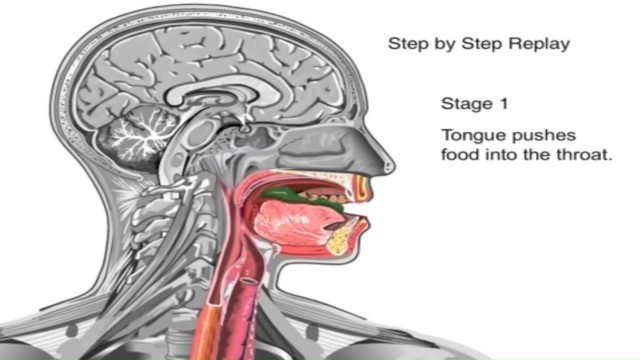

'The structures involved with the process of swallowing include the tongue, teeth, epiglottis, and esophagus. The teeth are used to grind and chop up food into tiny pieces, while the glands in the mouth moisten the food with saliva. In the first stage of swallowing, the tongue pushes the food into the throat. In the second stage of swallowing, an important small flap of tissue called the epiglottis, folds over the voice box (larynx) at the entrance to the windpipe (trachea), preventing food from going down the wrong way. In the final stage, the esophagus contracts and moves food toward the stomach. Stages of Swallowing: Safe and effective swallowing is dependent upon perfect timing of three basic stages, as well as the effective performance by many nerves and muscles involved in the process. The three stages of swallowing include: Oral Phase During the oral phase, food is chewed and mixed with saliva to form a soft consistency called a bolus. The tongue then moves the bolus toward the back of the mouth. Patients with impairment of the oral stage may experience difficulty creating a seal around a fork or spoon with their lips, chewing solid consistencies, forming chewed food into a bolus or moving the bolus to the back of the mouth. Pharyngeal Phase During the pharyngeal phase, the vocal folds close to keep food and liquids from entering the airway. The larynx rises inside the neck and the epiglottis moves to cover it, providing even more airway protection. If the pharyngeal phase is impaired, food or liquid can move into the throat before the automatic swallow is triggered, resulting in food or liquid touching the vocal folds or penetrating the vocal folds and moving into the lungs. Common symptoms include: Coughing before, during or shortly after swallowing A choking sensation Shortness of breath Changes in voice quality after swallowing Repeated pneumonia Weight loss Esophageal Stage During the final stage, the esophageal stage, the bolus moves into the esophagus, the muscular tube that contracts to push the bolus into the stomach. If the esophageal stage is affected, the patient might experience heartburn, vomiting, burping or abdominal pain. Swallowing, sometimes called deglutition in scientific contexts, is the process in the human or animal body that makes something pass from the mouth, to the pharynx, and into the esophagus, while shutting the epiglottis. Swallowing is an important part of eating and drinking. If the process fails and the material (such as food, drink, or medicine) goes through the trachea, then choking or pulmonary aspiration can occur. In the human body the automatic temporary closing of the epiglottis is controlled by the swallowing reflex. The portion of food, drink, or other material that will move through the neck in one swallow is called a bolus. In humans Coordination and control Eating and swallowing are complex neuromuscular activities consisting essentially of three phases, an oral, pharyngeal and esophageal phase. Each phase is controlled by a different neurological mechanism. The oral phase, which is entirely voluntary, is mainly controlled by the medial temporal lobes and limbic system of the cerebral cortex with contributions from the motor cortex and other cortical areas. The pharyngeal swallow is started by the oral phase and subsequently is co-ordinated by the swallowing center on the medulla oblongata and pons. The reflex is initiated by touch receptors in the pharynx as a bolus of food is pushed to the back of the mouth by the tongue, or by stimulation of the palate (palatal reflex). Swallowing is a complex mechanism using both skeletal muscle (tongue) and smooth muscles of the pharynx and esophagus. The autonomic nervous system (ANS) coordinates this process in the pharyngeal and esophageal phases. Phases Oral phase: Prior to the following stages of the oral phase, the mandible depresses and the lips abduct to allow food or liquid to enter the oral cavity. Upon entering the oral cavity, the mandible elevates and the lips adduct to assist in oral containment of the food and liquid. The following stages describe the normal and necessary actions to form the bolus, which is defined as the state of the food in which it is ready to be swallowed. There are 4 main stages in the swallowing process: Oral Preparatory Stage, in which the food is chewed (masticated), mixed with saliva, and formed into a cohesive ball (bolus) Oral Stage, in which the food is moved back through the mouth with a front-to-back squeezing action, performed primarily by the tongue'
Tags: Food , video , animation , biology , Saliva , stomach , teeth , human body , swallow , med , tongue , Anatomy , esophagus , mouth , throat , physiology , swallowing , windpipe , deglutition , trachea , epiglottis , swallowing reflex , process of swallowing , voice box , larynx , physiology of deglutition , swallowing mechanism , swallowing process , how swallowing occurs , what happens during swallowing , how swallowing works , voluntary phase of swallowing , swallowing steps , stages of swallowing , phases of swallowing
See also:

















comments